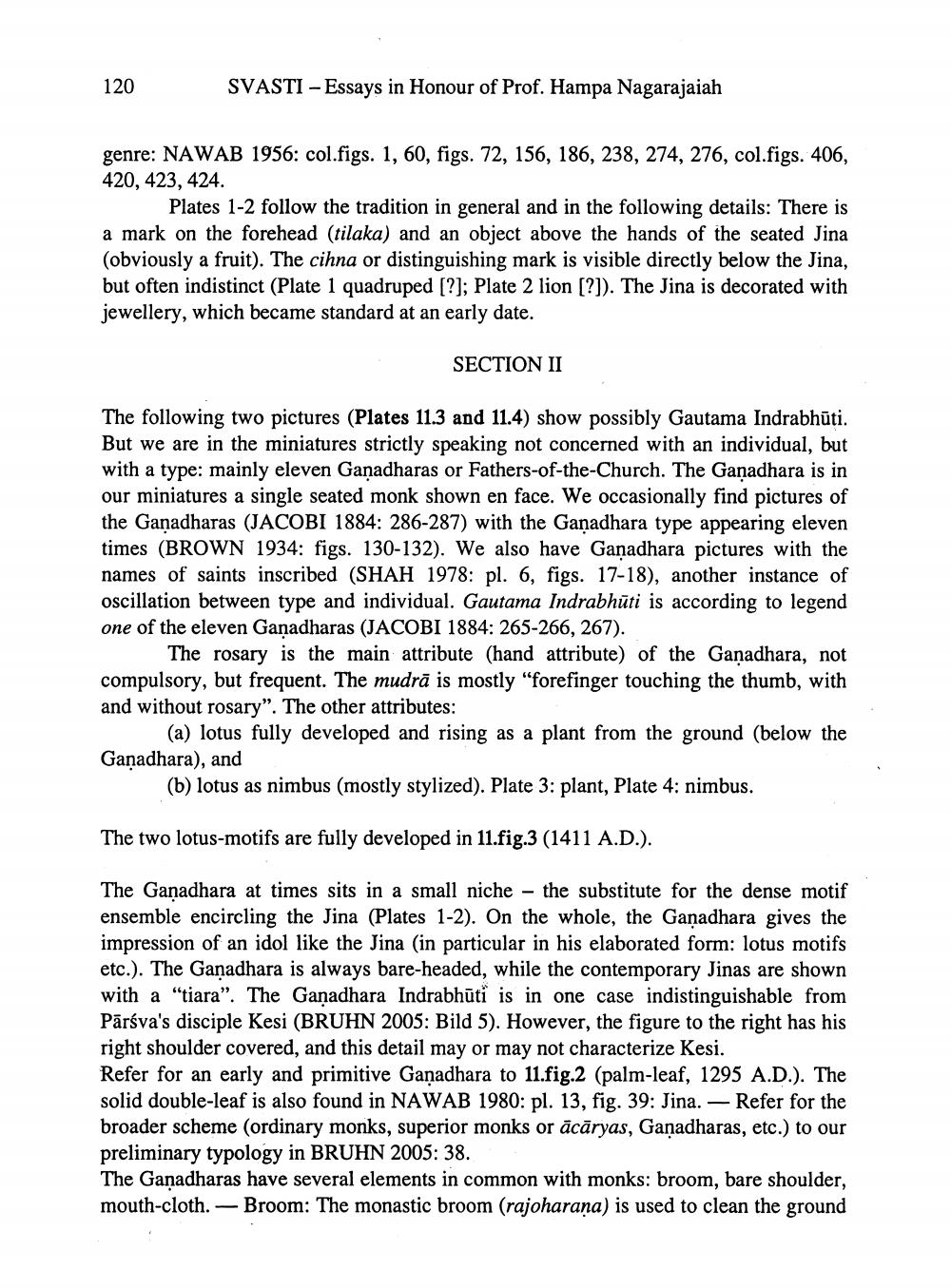________________
120
SVASTI Essays in Honour of Prof. Hampa Nagarajaiah
genre: NAWAB 1956: col.figs. 1, 60, figs. 72, 156, 186, 238, 274, 276, col.figs. 406, 420, 423, 424.
Plates 1-2 follow the tradition in general and in the following details: There is a mark on the forehead (tilaka) and an object above the hands of the seated Jina (obviously a fruit). The cihna or distinguishing mark is visible directly below the Jina, but often indistinct (Plate 1 quadruped [?]; Plate 2 lion [?]). The Jina is decorated with jewellery, which became standard at an early date.
SECTION II
The following two pictures (Plates 11.3 and 11.4) show possibly Gautama Indrabhūti. But we are in the miniatures strictly speaking not concerned with an individual, but with a type: mainly eleven Gaṇadharas or Fathers-of-the-Church. The Ganadhara is in our miniatures a single seated monk shown en face. We occasionally find pictures of the Ganadharas (JACOBI 1884: 286-287) with the Gaṇadhara type appearing eleven times (BROWN 1934: figs. 130-132). We also have Gaṇadhara pictures with the names of saints inscribed (SHAH 1978: pl. 6, figs. 17-18), another instance of oscillation between type and individual. Gautama Indrabhūti is according to legend one of the eleven Gaṇadharas (JACOBI 1884: 265-266, 267).
The rosary is the main attribute (hand attribute) of the Gaṇadhara, not compulsory, but frequent. The mudra is mostly "forefinger touching the thumb, with and without rosary". The other attributes:
(a) lotus fully developed and rising as a plant from the ground (below the Gaṇadhara), and
(b) lotus as nimbus (mostly stylized). Plate 3: plant, Plate 4: nimbus.
The two lotus-motifs are fully developed in 11.fig.3 (1411 A.D.).
The Ganadhara at times sits in a small niche the substitute for the dense motif ensemble encircling the Jina (Plates 1-2). On the whole, the Ganadhara gives the impression of an idol like the Jina (in particular in his elaborated form: lotus motifs etc.). The Ganadhara is always bare-headed, while the contemporary Jinas are shown with a "tiara". The Ganadhara Indrabhūti is in one case indistinguishable from Pārsva's disciple Kesi (BRUHN 2005: Bild 5). However, the figure to the right has his right shoulder covered, and this detail may or may not characterize Kesi.
Refer for an early and primitive Ganadhara to 11.fig.2 (palm-leaf, 1295 A.D.). The solid double-leaf is also found in NAWAB 1980: pl. 13, fig. 39: Jina. Refer for the broader scheme (ordinary monks, superior monks or ācāryas, Gaṇadharas, etc.) to our preliminary typology in BRUHN 2005: 38.
The Gaṇadharas have several elements in common with monks: broom, bare shoulder, mouth-cloth. Broom: The monastic broom (rajoharaṇa) is used to clean the ground




